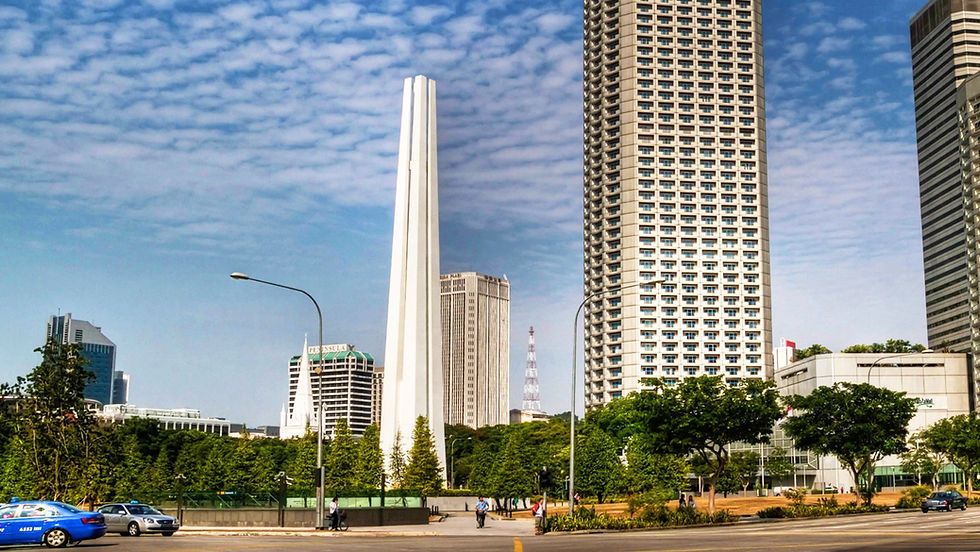A Journey Through the Civilian War Memorial's History
- lionheartlanders

- Feb 23, 2024
- 3 min read

Join our monumental walks and Japanese Occupation guided bus tour to discover the story behind the Civilian War Memorial and the symbolism in each landmark’s design as well as the hidden stories behind each sculpture and engraving. Read our story now to gain insight about the Civilain War Memorial.
In the bustling metropolis of Singapore, where modern skyscrapers dominate the skyline, there stands a solemn structure that serves as a poignant reminder of the nation's tumultuous past: the Civilian War Memorial. Erected in 1967, this monument transcends mere architectural significance; it encapsulates the resilience and unity forged amidst tragedy. Join us as we embark on a journey through the history of this iconic landmark, exploring its origins, symbolism, and enduring legacy.
A Legacy Forged in Suffering
The roots of the Civilian War Memorial trace back to the harrowing days of World War II. During the Japanese Occupation from 1942 to 1945, Singapore endured unimaginable suffering, with over 50,000 civilians falling victim to brutality, starvation, and mass executions. It was not until 1962, when mass graves containing their remains were uncovered, that the call for a memorial began to resonate strongly within the community.
From Graves to Pillars
Under the leadership of Prime Minister Lee Kuan Yew, the Singaporean government embarked on a mission to commemorate the lives lost during the war. Initially conceived as a large burial mound, public feedback steered the design towards a more symbolic representation. Architect Leong Swee Lim's vision prevailed, giving rise to four towering pillars, each standing at 67 meters tall, symbolizing the unity of Singapore's four main ethnic groups: Malay, Chinese, Indian, and Eurasian.

More Than Just Stone and Steel
The unveiling of the Civilian War Memorial in 1967 marked a poignant moment in Singapore's history, coinciding with the 25th anniversary of the island's fall. Beneath the solemn pillars lie urns containing the exhumed remains, serving as a perpetual reminder of the sacrifices made. Inscriptions in English and Tamil adorn the base, urging visitors to remember and remain vigilant against the horrors of war.
The "Chopsticks" and Their Significance
Affectionately referred to as "The Chopsticks" by locals due to its architectural resemblance, the memorial carries a profound message beyond its nickname. Like the utensils themselves, which function best in pairs, the monument symbolizes the importance of unity and collaboration. Just as chopsticks bring people together during a meal, the Civilian War Memorial aims to unite Singaporeans in honoring their shared history, fostering empathy and understanding across diverse communities.

A Beacon of Unity in Modern Times
Today, the Civilian War Memorial stands as a beacon of national identity and collective sacrifice. It serves as a solemn reminder of the past, promoting peace and harmony in the present. During annual remembrance ceremonies, wreaths are laid, and stories are shared, ensuring that the memory of those lost lives continues to inspire future generations.
Visiting the Memorial
A pilgrimage to the Civilian War Memorial is a poignant experience not to be missed. Located near Beach Road, adjacent to the historic Padang, the monument invites visitors to pause and reflect beneath its towering pillars. Take a moment to contemplate the inscriptions, pay homage to the fallen, and carry their legacy forward with reverence and respect.
Conclusion
The Civilian War Memorial transcends its physical presence to become a living testament to the indomitable human spirit's capacity to overcome adversity. Its story resonates not only within Singapore but also across the globe, serving as a timeless reminder of the importance of remembrance, unity, and the pursuit of a brighter future. As we honor the sacrifices of the past, let us also reaffirm our commitment to peace, harmony, and understanding in the present and generations to come.
Want to know more?
If you are interested in learning more topics like this, we have got you covered here. Make sure to visit the link to get to know the transformation of these historical places in Singapore.




Comments